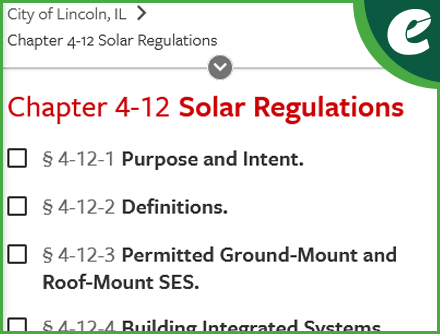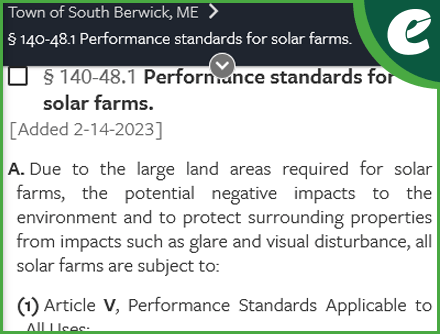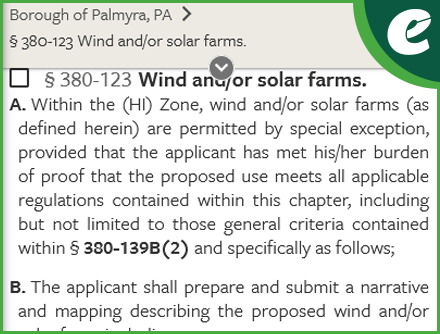“Here comes the sun, and I say it’s alright.”
That’s a sentiment widely shared by proponents of solar energy as the popularity of this clean renewable power source continues to surge. Today solar energy is the fastest growing and most affordable source of new electricity in the U.S. In fact, since 2022, the development of large-scale solar projects has grown by more than 77% according to the Solar Energy Industries Association (SEIA), largely due to strong policies aimed at eliminating dependency on carbon-emitting fossil fuels.
While these statistics are promising, an in-depth nationwide analysis conducted by USA TODAY shows that local governments are blocking and even banning green energy projects–including solar–faster than they’re building them.
View sample solar energy legislation >
Recharging the planet
According to National Grid, renewable or green energy is electricity produced by fuel sources that renew themselves and do not diminish when humans tap them for power. It’s called “green” because it is an ecologically friendly energy source that is good for the planet.
Green energy includes electricity from solar panels, wind turbines, hydroelectric dams and what’s known as biomass, which is burning wood, crop waste, or garbage. The shift to renewable energy is important because most of these power sources don’t produce greenhouse gasses that drive climate change. These gases, especially the carbon dioxide produced when coal, oil, or natural gas are burned, create a “blanket” in the atmosphere that holds in heat.
Setting new goals to keep pace with a changing climate
In 2023, 16% of US electricity came from solar and wind projects, according to the U.S .Energy Information Administration. Hydroelectric power produced 6% of U.S. electricity while biomass, which, includes ethanol blended into gasoline, made up about 5% of total U.S. energy consumption. As the planet warms and climate disasters become more frequent and grow more costly, the U.S. has set a target to reach 100% clean energy by 2035, a goal that depends on building large-scale solar and wind power.
It’s not easy being green
While solar power has found more broad acceptance as a new source of energy, 2023 was the first year to see almost as many individual counties block new solar projects as the ones adding their first projects. The result: some of the areas with the nation’s best sources of solar and wind power have now been boxed out. A recent article from Inside Climate News finds that the biggest obstacle to green energy production such as solar has been social acceptance. The article states that as solar and wind projects are proposed in more places, more communities seem to be deciding they don’t want anything to do with them. While anti-green-project-residents are not in the majority, members of the industry, along with policymakers and researchers, worry that such an increase in challenges will slow the overall pace of decarbonization and efforts to respond to climate change.
Many reasons to charge ahead
While there is some very vocal local opposition to solar projects due to fears of lower property values, the potential overuse of valuable rural land, and the desire to keep natural vistas unobstructed, there are equally as many—if not more reasons—to charge ahead with solar. According to Energy.gov, as a renewable source of power, solar energy has an important role in reducing greenhouse gas emissions and mitigating climate change, which is critical to protecting humans, wildlife, and ecosystems. Solar energy can also improve air quality, reduce water use from energy production, and provide ecosystem services for host communities through carbon sequestration, pollination, and ground and stormwater management. Because ground-mounted photovoltaics (PV) and concentrating solar-thermal power (CSP) installations require the use of land, sites need to be selected, designed, and managed to minimize impacts to local wildlife, wildlife habitat, and soil and water resources. The U.S. Department of Energy’s Solar Energy Technologies Office (SETO) supports research to better understand how solar energy installations, wildlife, and ecosystems interact and to identify strategies that maximize benefits to the local environment and host communities.
Flipping the switch on solar energy legislation
Cities, states, and federal governments nationwide are instituting policies aimed at increasing renewable energy. At least 29 U.S. states have set renewable portfolio standards—policies that mandate a certain percentage of energy from renewable source. More than 100 cities worldwide now boast at least 70 percent renewable energy, and still others are making commitments to reach 100 percent. Other policies that could encourage renewable energy growth include carbon pricing, fuel economy standards, and building efficiency standards. Corporations are making a difference too, purchasing record amounts of renewable power in 2018.
Pushing incentives to go solar
According to a recent article from The Republic of Solar, government initiatives that promote solar energy use are essential for reducing the damaging environmental effects of conventional energy sources. The following are some methods that governments can use to incentivize solar energy growth:
- Require utilities to produce a specific portion of their power from renewable sources, such as solar energy, by imposing Renewable Portfolio Standards (RPS) on them.
- Provide low-interest loans, tax breaks, and rebates to individuals and companies who make solar energy investments.
- Make available funding for solar energy technology research and development.
- Provide regulations that support the installation of solar panels on public structures and infrastructure.
- Create net metering regulations that enable individuals and organizations to resell extra solar power to the grid.
- Educate the public on solar energy’s advantages, including how it may lower power costs and improve energy security.
- Provide laws and guidelines that encourage the adoption of energy-saving equipment so that the total demand for energy can be decreased.
- Encourage the creation of energy storage systems that can save surplus solar energy for usage when solar output is low.
- Promote the creation of community solar projects that can supply low-income neighborhoods and tenants with solar energy.
- Collaborate along with private sector businesses to fund research and infrastructure for solar energy.
Useful examples of solar energy legislation from the eCode360® Library
If your community is considering enacting or updating zoning ordinances to address solar and other clean energy use in your community, some useful examples can be found in our eCode360 Library, including:
Additionally, the International Code Council (ICC) and the National Fire Protection Association (NFPA) collaborated to publish the 2021 International Solar Energy Provisions (ISEP), which compiles all solar energy-related provisions from the 2021 International Codes (I-Codes) and the 2020 NFPA 70 National Electrical Code (NEC). The ISEP consolidates building, electrical, fire, plumbing, energy, and mechanical requirements for solar energy systems into a single, comprehensive publication for easier field application.
Is your code on a schedule?
Did you know you can set up a regular update schedule, so you don’t have to worry about compiling materials or taking up time and resources of your staff to do the updates yourself? As your municipality passes legislation, send it to General Code and we’ll take care of the rest. It’s just that simple!
For tips that will allow us to process your code updates most efficiently, click here.
Questions about updating your code?
Our Client Care team is available to explain the options and benefits of scheduled code updates or any other code-related questions you might have.
Sources:
- Pros and cons of solar panels: They’re usually worth it:
- An activist group is spreading misinformation to stop solar projects in rural America
- How to Refute 5 Common Arguments of Renewable Energy Opponents
- Energy.gov: Biden-Harris Administration Launches New Solar Initiative to Lower Electricity Bills and Create Clean Energy Jobs
- USA Today: Across America, Clean Energy Plants are Being Banned Faster Than They’re Being Built
- Inside Climate News: The Choice for Rural Officials: Oppose Solar Power or Face Revolt
- NPR: In some fights over solar, it’s environmentalist vs. environmentalist
- Inside Climate News: Community Opposition and Grid Challenges Slow the Pace of Renewable Efforts, National Survey of Developers Shows
- Energy Markets & Policy: New research yields insights into attitudes and perceptions of large-scale solar project neighbors
- PV Magazine: Opposition Stymies solar– sometimes
- Republic of Solar: The Role of Government Policies in Promoting the Adoption of Solar Energy
- International Code Council (ICC) Announces 2021 Solar Energy Provisions
- Wikipedia
- eCode360® Library






